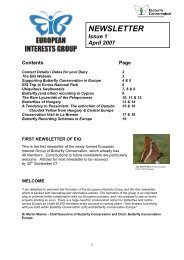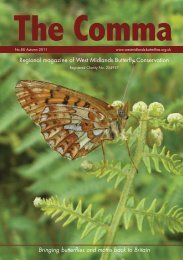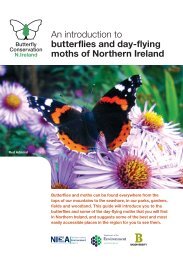Spring 2012 newsletter - Butterfly Conservation
Spring 2012 newsletter - Butterfly Conservation
Spring 2012 newsletter - Butterfly Conservation
You also want an ePaper? Increase the reach of your titles
YUMPU automatically turns print PDFs into web optimized ePapers that Google loves.
Butterflies<br />
of<br />
Northamptonshire<br />
Order your<br />
copy now!<br />
Details of content, publication<br />
date, price and how to order<br />
are given overleaf<br />
e buery habitats of Northamptonshire<br />
Details of ten important sites with public access to see the bueries of the county<br />
Descriptions, life cycles, trends and distribution maps of the 36 species resident in the county<br />
Historical summaries of rare migrants and extinct species<br />
300 photographs in full colour<br />
Features on the work of Buery <strong>Conservation</strong> and management for key species, Gardening<br />
for Bueries, ‘BB’ and the Purple Emperor<br />
UK Price £11.99<br />
ISBN 978-0-9520291-3-7<br />
Orange-tip<br />
Anthocharis cardamines<br />
Male (wingspan 46mm.)<br />
e Orange-tip is a well distributed and common buery in our area<br />
and its conspicuous markings and tendency to roam over a wide area<br />
mean that it is well recorded, though the vagaries of the s pring weather<br />
ensure that there are uctuations in the population of the adults and the<br />
number of observations from year to year. It would have been much more<br />
numerous in the past but the destruction of hedgerows, drainage of wet<br />
meadows, and intensive agricultural practices have changed the scale of<br />
abundance.<br />
Local Distribution and Status<br />
00<br />
90<br />
80<br />
70<br />
60<br />
50<br />
50<br />
40<br />
e delicate male Orange-tip cannot be confused with any other species,<br />
the orange tips to the forewings being visible from some distance when<br />
the species is in ight. On closer inspection these can be seen to have a<br />
black edge and a clear, black discal spot. e female can be confused with<br />
other Whites unless observed closely; it possesses similar markings to<br />
the male but lacks the orange markings. When at rest with wings closed<br />
both sexes have a moled green appearance on the hindwings created<br />
by an arrangement of yellow and black scales. Male Orange-tips are very<br />
photogenic when on Bluebells or Bugle owers.<br />
30<br />
50 60 70 80 90 00 10<br />
e appearance of the Orange-Tip in spring marks the true arrival of the<br />
buery season. Its principal habitats are lanes, hedgerows, river banks,<br />
damp meadows, roadside verges and woodland rides where its great<br />
mobility makes it a common species. May is the usual month to look<br />
for it though in recent years the rst specimens have begun to appear<br />
consistently in April. ere is a single generation and by June few are seen,<br />
except in late springs when it can be on the wing even into July. Breeding<br />
success is determined by the weather since the buery only ies in<br />
bright sunshine. If conditions are warm, it can still be on the wing into the<br />
evening. As soon as the sun disappears behind a cloud it closes its wings.<br />
Cow Parsley and Garlic Mustard are common roosts and the cryptic<br />
underside colouring creates an excellent camouage. As the sun returns,<br />
it slowly opens its wings before resuming the steady, undulating ight<br />
which takes this mobile lile buery over a wide area. Males will patrol<br />
endlessly up and down a set area looking for females. Days of intermient<br />
sun and cloud are ideal for photographing this prey insect.<br />
e beautiful underside markings of the male<br />
L i f e C y c l e<br />
<strong>Butterfly</strong><br />
<strong>Conservation</strong><br />
A number of foodplants of the crucifer family are used for egg-laying. By<br />
far the most successful is Garlic Mustard, but Hedge Mustard provides a<br />
good substitute while in damper areas and woodland rides Lady’s Smock<br />
is also utilised. All three of these are also readily accepted as nectar plants<br />
though the species will feed from a wide variety of owers. Caterpillars<br />
have also been found on Tower Mustard, Bastard Cabbage, Honesty,<br />
Garlic Mustard and even Oilseed Rape. Eggs have been recorded<br />
on Shepherd’s Purse, but without success. When rst laid, the egg is<br />
translucent but turns a bright orange within a few days and is the most<br />
conspicuous of any buery species as it is laid on the stalk of a plant just<br />
below the ower head. Several eggs found on the same plant stalk will<br />
be the product of dierent females. e caterpillars of the Orange-tip are<br />
renowned for their cannibalism when young.<br />
e caterpillar usually feeds on the seedpods of its chosen plant. When<br />
it rst hatches, it is orange with black spines and a black head. Later it<br />
becomes greener, until when fully grown it exhibits a ne example of<br />
counter-shading, lighter above and dark green below. is prevents it from<br />
casting a shadow which would betray its presence as it rests alongside<br />
the stalks or seedpods, a position which makes it quite dicult to spot.<br />
Even so, many are eaten by birds. e chrysalis is extremely dicult<br />
to nd in the wild and the buery spends around ten months in this<br />
stage, including the winter. e mustard oil which it has derived from the<br />
A mating pair, male above, female below<br />
foodplants of the caterpillar makes the adult buery unpalatable to birds<br />
and the bright orange of the male advertises this, an example of warning<br />
colouration.<br />
Over-enthusiastic trimming of roadside verges destroys the species in its<br />
early stages but cutbacks in Local Authority spending have arrested this<br />
trend and the buery has actually extended its range in Britain in recent<br />
years. A few more wild patches le here and there in parks and gardens<br />
would assist it further. Long may we continue to see this harbinger of<br />
spring.<br />
F e m a l e<br />
E g g<br />
Caterpillar<br />
Chrysalis<br />
<strong>Butterfly</strong><br />
Douglas Goddard & Andy Wyldes<br />
e egg is easy to nd on Lady’s Smock<br />
Butterflies of Northamptonshire<br />
e caterpillar feeds on the developing seed pods of its foodplant<br />
Jan F e b Mar Apr M a y Jun Jul Aug Sep Oct Nov Dec<br />
51<br />
Buerflies<br />
Northamptonshire<br />
Douglas Goddard & Andy Wyldes<br />
‘BB’ and the Purple Emperor<br />
Denys Watkins-Pitchford, who wrote under the pseudonym ‘BB’, was an eminent naturalist-writer who was born in<br />
Northamptonshire and spent his life here. His fascination for the Purple Emperor (Apatura iris) began when he was young<br />
-“I used to spend hours reading about it in my Frohawk’s British Bueries, looking longingly at the colour plate which<br />
showed the insect in all its regal purple sheen, and I used to think that the outside of its wings was even more beautiful,<br />
with its greenish whorls and marblings and the rich coloured eye on the forewing tips.” ‘BB’ began a persistent search for it,<br />
when he found that it was ‘most frequent in Northamptonshire and Lincolnshire.’<br />
Old sites for the buery were Barnwell Wold and the woods around<br />
In his book Ramblings of a Sportsman-Naturalist, ‘BB’ describes the life<br />
Polebrook, while in Geddington Chase in 1878, a man had captured over cycle of this beautiful insect in great detail and reveals what a marvellous<br />
a dozen in a single day. ‘BB’ also mentions newspaper cuings referring observer and entomologist he was. On hatching the caterpillar eats the<br />
to an Emperor being seen and captured at Yardley Chase. A well-known eggshell and then moves to the leaf tip where few predators explore and<br />
Victorian entomologist, the Rev. William Bree, rector of Polebrook, once where the moisture drains o to protect it. He describes the minute beetle<br />
caught a specimen in his hat down a riding in Ashton Wold. On a visit Anthocoris nemorum and its devouring of the tiny caterpillars. Much skill is<br />
to his church, ‘BB’ surmised that he must have preached on many a hot needed to protect them from other enemies, such as spiders and earwigs,<br />
summer aernoon, his mind no doubt wandering to the rides of the<br />
and to tend them so that they survive the winter.<br />
adjacent woods where the Purple Emperor was found. He tells us the<br />
buery was still at Ashton in 1943, but only as a rarity.<br />
In 1973, ‘BB’ tells us that he released 25 adult Purple Emperors into ‘the<br />
Chase’. It is not clear exactly where he means, but this was most probably<br />
‘BB’s early searches for the Purple Emperor found much of the habitat<br />
the ride in Fermyn Wood known as ‘Emperor Ride’, a few minutes’ walk<br />
unsuitable. In 1940 while wandering round Monk’s Wood, a former good from his home. e following year, he found eggs to conrm that they<br />
site for it, he describes meeting an entomologist of the old school with his had indeed bred there. On July 28th 1978 he found 18 eggs and a female<br />
Emperor net 15 high, and he was amused by his pretended ignorance, intent on laying. In 1980, he refers to them as, “the Purple Emperors of<br />
while ‘his sly thirst for information suggested he was a professional<br />
mine (they really were mine, of my own stocking, for as far as I know, iris<br />
collector.’ Aer a brief view of his long sought aer prize in Salcey Forest, did not occur in this forest in recent years).”<br />
‘BB’ nally ‘came face to antennae with iris’ properly for the rst time in<br />
1946. He accompanied Stuart Humfries, an eminent eye-surgeon, to a<br />
wood in Oxfordshire. Having seen a Purple Emperor sele high up on<br />
an oak leaf, he and Humfries seeing a timber truck with wheels nearby<br />
dragged it under the tree, so that ‘BB’ could reach with his net. He made<br />
a sweep for it but it had vanished into thin air. e same day a worn male<br />
circled twice round his head and seled on his knee.<br />
It is clear from his writing that oak woodland was ‘BB’s favourite habitat,<br />
and he extols the wide rides bathed in hot sunlight on a July aernoon,<br />
the cool shadows banding the rides, the sound of the turtle doves<br />
and bullnches, humming ies and the smell of the Meadowsweet.<br />
Subsequent visits to Salcey Forest brought many happy sightings of the<br />
Purple Emperor before spraying to eliminate Oak Tortrix moths led to<br />
its extinction in the 1960s. In 1948, he saw a female laying an egg and<br />
plunged into a ditch to pull down a sprig of Sallow to inspect it. Salcey<br />
also inspired his book Brendon Chase and here in a shady ride one day, he<br />
encountered John Phillips, a Keering surgeon who taught him how to<br />
nd the buery’s eggs successfully.<br />
Eggs can be found on the lower branches of large Sallows but climbing<br />
high into the upper branches may yield even more. One eminent<br />
entomologist, a very big and heavy man, fell and injured himself so badly<br />
that he died later. ‘BB’ regarded the death of a well-known collector, killed<br />
aer falling in a ditch while searching for eggs, as a ing end, and was<br />
prepared to take the risk on many occasions. Once able to gather eggs, he<br />
admied that the ‘iris bug’ had bien even deeper and he vowed to tend<br />
the caterpillars through the winter. It became his mission to reintroduce<br />
the Purple Emperor to its ancient stronghold.<br />
BB watches the release of his bueries into “Emperor Ride” in the mid 1980’s<br />
photographed by Jack Steward<br />
78<br />
of<br />
In the 1982 season, he only found two eggs as the vision in his right eye<br />
had become impaired to the extent that locating them was becoming<br />
too dicult. By then, however, his labours had begun to bear fruit.<br />
Ian Flinders’ survey of the bueries of Northamptonshire 1976-81<br />
had deemed the Purple Emperor extinct but subsequent to this, local<br />
enthusiasts had begun to nd it again in the woods around Brigstock.<br />
It could be seen only a few hundred yards from the Round House in<br />
Sudborough. During the 1990s it had begun to appear regularly and<br />
extended its range here so that it is now found throughout most of the<br />
old Rockingham Forest. In the current millennium Purple Emperors<br />
have been seen regularly in the Silverstone area, particularly Bucknell<br />
and Hazelborough Woods and, on one occasion, Whistley Wood. e<br />
species was recorded again in Yardley Chase from 2009 and a discovery of<br />
a caterpillar by a Northants Wildlife Trust worker conrmed its breeding<br />
there in 2011. is year also saw its return to Salcey Forest aer half a<br />
century with two separate sightings.<br />
Above: A male and female Emperor raised by ‘BB’ are released into ‘Emperor Ride’ in the mid 1980s. Photograph by Jack Steward<br />
Right: e Round House at Sudborough, ‘BB’s home for a number of years, right on Fermyn’s doorstep<br />
Below: ‘Emperor Ride’ in Fermyn as it is today<br />
As a result of climate change the Purple Emperor is extending its range<br />
nationally. It has become widespread in Oxfordshire, another old haunt,<br />
and has been recorded in Warwickshire, Suolk and Cambridgeshire in<br />
recent years. Sallow regenerates quickly on the clay soils of our county and<br />
Fermyn Wood has the perfect conditions for it, the habitat developing<br />
particularly aer ‘BB’s death in 1990. What role the writer played in its<br />
current expansion is dicult to establish. It may be that the buery was<br />
there all along and his intervention helped the population to reach the<br />
level where it began to be seen more readily. It is nonetheless a source<br />
of great pleasure to feel that current buery enthusiasts are treading in<br />
the same woodland rides into which he ventured and to reect that his<br />
cherished dream of seeing ‘His Imperial Majesty’ ying there again is now<br />
an ongoing success, a ing monument to this great naturalist.<br />
By Douglas Goddard & Andy Wyldes<br />
79







